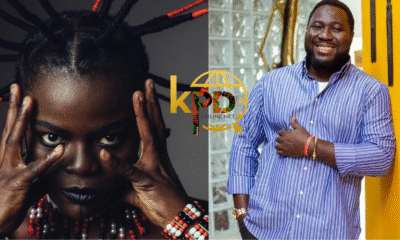Entertainment
FOCAP Vice President Mel Kwesi Davis Writes; Rethinking National Budgets: Why Ghana Must Prioritize the Creative Economy

When Sarkodie’s Rapperholic lit up Kumasi, it was more than just a concert. It was proof that Ghana’s creative sector isn’t a fringe industry, it’s an engine of growth, employment, identity and global relevance. The evidence is mounting: culture does drive commerce. Yet, paradoxically, our national budgets keep postponing the investment that’s already paid for itself many times over.
Here’s what recent data tells us and why immediate structural funding for the creative economy is not just desirable but essential.
https://youtu.be/S29XDWzzGOs?si=ctj5cLGLbJIWzRXq
Youth Unemployment & Underemployment.
The unemployment rate among youth aged 15-35 is around 19.7% as of 2023.
Among those aged 15-24, the rate is about 32%.
In the broader 15-35 age group, 22.5% are without employment.
Gender and geography matter: young women face higher unemployment (≈ 22.3%) compared with young men (≈ 17.4%). Urban areas show somewhat worse rates than rural ones.
There are also large numbers of youth classified as “NEET” (Not in Education, Employment, or Training). For example, about 1.8 million youth (roughly 28.8% of those aged 15-24) fell into this category in recent surveys.
The youth population continues to grow: in the 2020 Population & Housing Census, youth made up 38.2% of Ghana’s population.
The Creative Sector and the GDP of Ghana.
In 2022, the Global Citizen Festival held in Accra injected over USD 15 million into Ghana’s economy via production spending, hotels, transport, advertising, security and related services.
Creative sector share of GDP: The last formal estimate (UNESCO, 2010) placed Ghana’s cultural & creative industries at 1.53 % of GDP, counting only formal industries. Experts believe the figure is notably higher if informal creative activity is included.
Government stakeholders and commentators have posited that the creative industry could be leveraged to generate US$4 billion by 2028 in revenue for Ghana, if properly supported
In 2023, the Ministry of Tourism, Arts and Culture was allocated GH¢115,694,000; in 2024, this rose to GH¢260,948,961. Strikingly, in the 2025 budget, the tourism and creative arts sector was not mentioned or allocated any funds..
Other African countries offer models: Rwanda’s creative & arts sectors reportedly contribute 5.3% of GDP. Kenya has set objectives (through its arts & digital innovation strategies) for double-digit contributions (10%) in the near term.
The Global Citizen Festival example (2022) saw increased hotel occupancy (75%), over 5,000 international travellers coming for the event and over 1,000 local people employed for the event.
“December In GH” (a mix of concerts, festivals, fashion shows and cultural events) is increasing in scale: about 115,000 people in Dec 2023 vs 108,000 in Dec 2022, highlighting growing demand for cultural-tourism moments
Armed with the information stated and other research materials, below are some proposed allocation spends for the government to consider.
1. Component: Creative Sector Emergency Fund
Purpose: Immediate relief for event promoters, artists, and venue owners to help with production, logistics, safety, licensing, etc.
Proposed Allocation: Set aside ≈ GH¢150-200 million ring-fenced within mid-year budget or via supplementary funding to MoTAC (Ministry of Tourism, Arts & Culture). This could be matched with private sector/donor contributions.
2. Component: Annual Creative Infrastructure Budget.
Purpose: Build and maintain venues (concert halls, studios, outdoor amphitheatres) especially in regions outside Accra; upgrade lighting, acoustics, seating, security.
Proposed Allocation: Over 3 years, allocate GH¢500 million total with phased rollout: e.g., GH¢150 million in Year 1, GH¢175 million in Year 2, GH¢175 million in Year 3. Prioritise regional hubs (e.g., Kumasi, Takoradi, Tamale).
3. Component: Skills Development, Training & Mentorship.
Purpose: Since many youth are unemployed or underemployed, targeted creative sector training (sound engineering, stage production, digital content creation, event management) can upskill them; mentorship to help professionalise creative work.
Proposed Allocation: Allocate GH¢30-40 million annually for this purpose; partner with YEA (Youth Employment Agency), private sector, NGOs; include accelerator or incubator programs.
4. Component: Tax Incentives & Support for Youth Creative Startups.
Purpose: Young people often struggle with the cost of equipment, licensing, and venue booking; incentives would reduce barriers to entry.
Proposed Allocation: Introduce tax rebates for young creative entrepreneurs; matching grants; subsidised access to public venues; GH¢50-70 million/year set aside for these incentives.
5. Component: Data & Monitoring with Youth-Specific Indicators.
Purpose: To track how many youth are employed in creative sectors, rates of underemployment, gender splits, informal vs formal status, and help policy targeting.
Allocation: Commission Ghana Statistical Service, in collaboration with MoTAC, to design and implement a youth creative employment survey; GH¢10-15 million/year.
6. Component: Emergency & Youth Creative Fund.
Purpose: 30,000–50,000 youth (across event production, artist support, promotion, media)
Proposed Mechanic: Based on scaling existing small festivals and creative businesses, plus matching private sector investment.
7. Component: Infrastructure & Venues in Regions.
Purpose: 50,000–80,000 youth employed in construction, maintenance, event services, and venue management
Mechanic: Assumes phased build-out of regional creative hubs, studios and public performance spaces.
7. Component: Skills Development / Masterclasses / Incubation.
Purpose: 70,000–100,000 youth upgraded into formal or semi-formal creative sector roles (production, sound engineering, video, design, digital media)
Mechanic: With regular cohort training, mentorship, and accredited programs.
8. Component: Incentives & Startup Seed Capital.
Purpose: 20,000–30,000 youth can start small creative enterprises and sustain them over 2-3 years
Mechanic: With tax breaks, grants/subsidies, capital support, and business training.
Why Waiting Is Costing Ghana.
Each systemically underfunded event or delayed infrastructure means local businesses lose out on income (hotels, food vendors, transportation) that do not get recovered..
Branding & tourism relations: Cultural festivals, concerts, and artist branding help attract international visitors. Ghana has already seen successes like “Year of Return” and “Global Citizen” having a spillover into tourism. Failing to capitalise means losing to competing African countries.
Inflation / rising costs: The cost of production, importation of equipment, venue maintenance, security, etc., is rising. What seems viable now may be unaffordable later. Early investment often gets more “bang for cedi.”
With the 2025 budget notably omitting allocations for tourism & the creative arts, the government sends the wrong signal: that promises are more valuable than follow-through, but budget mechanics exist; policies can be structured; allocations can be made. Nations are built in the present.
Mel Kwesi Davis.
Vice President of the Foundation Of Concerned Art Professionals (FOCAP).
Continue Reading



















![JUST IN: Bibiani-Ahwiaso MCE Dead After A Tragic Accident [VIDEO]](https://enewsghana.com/wp-content/uploads/2022/07/FotoJet-1-5-80x80.jpg)
!["I Am One Of The Black Stars" - Inaki Williams Says As he announces Nationality Switch [WATCH]](https://enewsghana.com/wp-content/uploads/2022/07/Imaki-80x80.jpg)